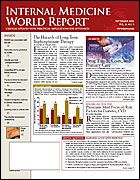Publication
Article
Internal Medicine World Report
High Homocysteine Levels Linked to Hip Fracture Risk
Author(s):
From the Endocrine Society
BOSTON—Primary care physicians may want to consider counseling their older female patients (>50 years) to boost their levels of folic acid (folate) to help decrease their risk of hip fracture and cardiovascular disease, suggest results of a new study presented at the 88th Annual Meeting of the Endocrine Society.
Previous studies have shown that high serum homocysteine levels may increase the risk of coronary artery disease, stroke, and dementia, and that folate levels affect homocysteine levels. The strong relationship between what an individual eats and the level of homocysteine suggests that overall health risks may be mitigated simply by changing one’s diet.
Now new data demonstrate a connection between risk of hip fracture and high levels of plasma homocysteine, a sulfur-containing amino acid. A research team that included investigators from several medical centers conducted a nested case-control study within the Women’s Health Initiative Observational Study to examine the relationship between homocysteine and the risk for incident hip fractures.
A total of 391 patients with new hip fracture and 391 matched controls were selected from this multiethnic cohort study of American postmenopausal women (n = 93,676). Women taking baseline medications containing estrogen (in oral and dermal forms), androgens, selective estrogen receptor modulators, antiestrogens, or those women being treated for bone loss (with bisphosphonates, calcitonins, or parathyroid hormone) were excluded from the study.
The cases were matched for date of blood drawn (within 4 months), and all fractures were evaluated and confirmed by physicians. After measuring homocysteine levels using a high-performance liquid chromatography assay, investigators determined that women with the highest levels of homocysteine had almost twice the risk of fracture.
“Our results showed that there was a significant association between homocysteine levels and risk of hip fracture, so there was a linear increase in the risk of hip fracture the higher the homocysteine levels,” said investigator Meryl LeBoff, MD, of Harvard Medical School, and director of the Skeletal Health and Osteoporosis Center and Bone Density Unit at Brigham and Women’s Hospital, Boston. “High homocysteine levels can lead to disruption of the collagen in bone and may act through other factors to reduce bone strength and lead to osteoporosis and fractures.”
Among the limitations of this study were its observational design and the fact that only 1 measurement of homocysteine was recorded for each woman. However, this is the largest study of its kind to find an association between homocysteine levels and increased risk of hip fracture.
“Further studies are needed to determine the mechanisms through which homocysteine levels contribute to increased fracture risk of the hip and whether fracture risk can be modified through nutritional factors,” Dr LeBoff told IMWR. “It might be something to consider to lower levels with folate and B vitamins, because we showed that one can do that with the study. However, this study was not designed to see whether raising folate and B vitamin intake can decrease hip fracture risk. So further studies are necessary.”





